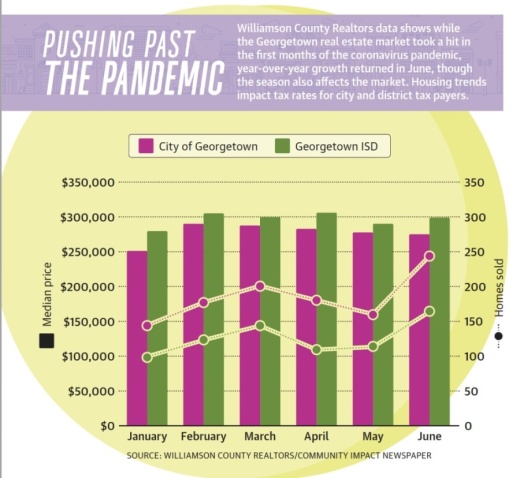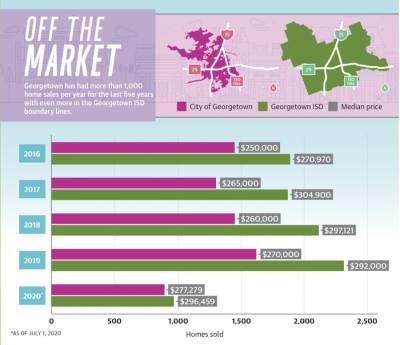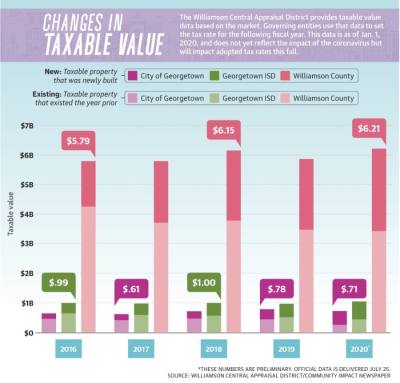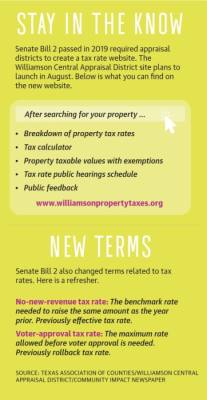She said though there were a few hiccups, for the most part it was smooth sailing—a parallel to the Georgetown real estate market as a whole during the first few months of the pandemic.
While most businesses halted and industries scrambled to minimize the damage, Georgetown’s real estate industry remained largely intact, and market prices remained at their current worth even as people stayed in.
Bryan Hutchinson, CEO of Williamson County Realtors, said the minimal damage can be attributed to Williamson County Judge Bill Gravell’s decision to deem real estate as an essential industry as well as the county clerk’s office’s recent move to an electronic filing system and Gov. Greg Abbott’s decision to allow electronic notarization. Without these, he said, the outcome would have been different.
“These activities by the government, coupled with Williamson County Realtors acting both prudently and practically in how they conducted business, helped to make sure that the impact on consumers here was minimized,” Hutchinson said. “While there was certainly a year-over-year drop, the data would have been tragically and exponentially worse if not for the collective effort of these decision-makers.”
Bradley put her home on the market right as Williamson County issued its “Stay Home Stay Safe” order March 24. She said she became nervous when in its first week on the market her home only got one showing. But as Realtors adapted, offering showings virtually, interest increased, and within a week and a half her home was sold at about $1,000 below asking price, she said.
She attributed the quick pace of the sale to the Realtors involved who were able to quickly adapt to the changing times. She added that from her experience, she does not believe the pandemic should disrupt anyone’s decision to sell their home or move.
“Understand that things might take a little longer than they usually would in this situation, with paperwork and processes sometimes taking a little longer because people are working remotely, ... but if you go into it understanding that you are going to have to have some grace, I think everybody will end up happy in the end,” Bradley said.
Impact of COVID-19
In March, 144 homes were sold in Georgetown, a 24.1% increase year over year. In fact, the start to 2020 was great for Georgetown real estate, where the number of homes sold was up by double digits year over year—a trend that has continued since July 2019.
But when the city began to shut down, fewer homes were sold, and fewer homes were put on the market, data shows. In April, Georgetown saw a 25.3% decrease in year-over-year sales, followed by a 31.5% year-over-year decrease in May.
Georgetown Realtor Kriston Wood said fewer homes were on the market due to fear of what the pandemic could bring, including changes in employment and income causing people to rethink their move or sell.
“The results of pulling back for safety measures in response to COVID-19 did impact real estate in Georgetown,” Wood said in an email. “The market slowed for some time as the city readjusted and people regained some clarity around what their new situation would be, financially, personally or otherwise.”
But Wood said she has seen buyer and seller confidence and urgency increase factoring in to June sales. Because of that, she said she expects the gap created by the pandemic to close soon.
In June, Georgetown saw a 12.3% increase in year-over-year sales.
“Our business economy is strong in Texas, and people are flocking to Georgetown, or Williamson County in general, to grow their businesses and enjoy the slower pace of life this beautiful city has to offer. This has kept Georgetown insulated from market extremes,” Wood said.
And while the number of homes decreased, price was hardly impacted, volleying from the high $270,000s to the high $280,000s for most of the last 12 months, data shows.
Georgetown Realtor Russ Phillips said even with fewer available contracts, real estate is still succeeding in the city. He said he and his team of four are faring well. They closed close to 20 homes in April and 20 more in June.
“I’m not sure if this will be our best year ever, but it will definitely certainly be up there,” Phillips said, despite the pandemic.
Phillips added even as sales are improving, he is reluctant to believe Georgetown real estate is out of the woods.
“[The pandemic] is not going to impact us as dramatically as maybe we thought in the beginning, but I feel like I am going to hold out judgement until we are six months deeper in this story to figure out what happens when all the stimulus money is gone and the unemployment realities are either gone away or recovered or lingered,” Phillips said.
Impact on appraisals
The coronavirus pandemic has not yet impacted appraisals, said Alvin Lankford, Williamson Central Appraisal District chief appraiser. That impact will not be seen until 2021, if there is one, he said.
However, the continued growth of the city is seen in the data.
Georgetown saw a $710 million increase in taxable value year over year, according to WCAD data. Of that, the city saw $470 million in new improvement value, which is about $130 million more than the year prior, per the data.
“The new value within Georgetown had an annual increase in 2020, based on properties built in 2019, [and] is the largest amount of growth of new value property that we have seen in Georgetown in recent years,” Lankford said. “It’s still a growing area that has impacted our market for quite some time here in Williamson County.”
The city also saw a $250 million increase in existing property value from the year prior. The increase was not as high as in years past—$440 million in 2019 and $460 million in 2018—but Lankford said a large reason for that is because the WCAD was more conservative in evaluating properties in an effort to reduce protests due to the pandemic.
“The value increase on existing properties—properties that already were in existence the prior year—is the lowest increase it has been for a number of years in Georgetown,” Lankford said. “That’s partially due to the market not being as fruitful this past year for the number of homes, but the real issue is conservative valuations during a time of the pandemic.”
Lankford said the WCAD sent out conservative home values to owners in March because it knew it was sending out values at the height of the pandemic, and with new health and safety regulations in place, WCAD was trying to reduce the number of visitors to its office. By doing so, the WCAD saw 12,000 fewer visitors in its physical office than the year before, Lankford said.
The WCAD also adapted to the pandemic by offering protests via video conference, a change Lankford said they will likely keep.
The reduction in protests allowed the WCAD to stay on schedule in delivering certified appraisal data to taxing entities—such as cities, counties and school districts—by July 25, he said.
Lankford added that the WCAD is only responsible for providing the data based on the market, and it is then up to the taxing entities to set the tax rate. If elected officials set a rate that is not reduced equally to the rate of growth, they are choosing to increase taxes, he said.
But to help residents get more involved in their property taxes, the Texas Legislature passed Senate Bill 2 in 2019, requiring appraisal districts to set up a tax rate website that allows for more transparency in the tax rate process. On it, homeowners can find a breakdown of property tax rates, their property taxable values with exemptions as well as their tax rate public hearings schedule if they would like to address the taxing entity.
The website will go live in August.
“We’re a mirror reflection of what happens in the real estate market,” Lankford said. “Whatever properties are selling for is what we are going to place on the roll. So really it’s up to buyers and sellers out there on what they are asking for and what they are willing to pay for the homes and businesses in our county that dictate how the values will be in 2021.”








